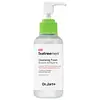What's inside
What's inside
 Key Ingredients
Key Ingredients

 Benefits
Benefits

 Concerns
Concerns

 Ingredients Side-by-side
Ingredients Side-by-side

Melaleuca Alternifolia Leaf Extract
PerfumingWater
Skin ConditioningDisodium Laureth Sulfosuccinate
CleansingSodium Cocoyl Glutamate
CleansingMethylpropanediol
Solvent1,2-Hexanediol
Skin ConditioningAcrylates/C10-30 Alkyl Acrylate Crosspolymer
Emulsion StabilisingSalicylic Acid
MaskingMelaleuca Alternifolia Leaf Oil
AntioxidantCentella Asiatica Extract
CleansingFicus Carica Fruit Extract
HumectantPolyglyceryl-10 Laurate
Skin ConditioningAnthemis Nobilis Flower Extract
MaskingCamellia Sinensis Leaf Extract
AntimicrobialGlycyrrhiza Glabra Rhizome/Root
EmollientAmaranthus Caudatus Seed Extract
Skin ConditioningUlmus Davidiana Root Extract
Skin ConditioningHamamelis Virginiana Extract
AntiseborrhoeicUndaria Pinnatifida Extract
Skin ConditioningGloiopeltis Furcata Extract
Skin ConditioningAloe Barbadensis Leaf Extract
EmollientCinnamomum Zeylanicum Bark Extract
AntimicrobialPinus Pinaster Bark Extract
AntioxidantButylene Glycol
HumectantDisodium EDTA
Hydrogenated Lecithin
EmulsifyingCeramide NP
Skin ConditioningAllantoin
Skin ConditioningNiacinamide
SmoothingSilica
AbrasiveCapryloyl Glycine
CleansingHexylene Glycol
EmulsifyingCamphor
MaskingSarcosine
Skin Conditioning4-Terpineol
MaskingMethyl Methacrylate Crosspolymer
Melaleuca Alternifolia Leaf Extract, Water, Disodium Laureth Sulfosuccinate, Sodium Cocoyl Glutamate, Methylpropanediol, 1,2-Hexanediol, Acrylates/C10-30 Alkyl Acrylate Crosspolymer, Salicylic Acid, Melaleuca Alternifolia Leaf Oil, Centella Asiatica Extract, Ficus Carica Fruit Extract, Polyglyceryl-10 Laurate, Anthemis Nobilis Flower Extract, Camellia Sinensis Leaf Extract, Glycyrrhiza Glabra Rhizome/Root, Amaranthus Caudatus Seed Extract, Ulmus Davidiana Root Extract, Hamamelis Virginiana Extract, Undaria Pinnatifida Extract, Gloiopeltis Furcata Extract, Aloe Barbadensis Leaf Extract, Cinnamomum Zeylanicum Bark Extract, Pinus Pinaster Bark Extract, Butylene Glycol, Disodium EDTA, Hydrogenated Lecithin, Ceramide NP, Allantoin, Niacinamide, Silica, Capryloyl Glycine, Hexylene Glycol, Camphor, Sarcosine, 4-Terpineol, Methyl Methacrylate Crosspolymer
Salicylic Acid 2%
MaskingWater
Skin ConditioningSodium Laureth Sulfate
CleansingDecyl Glucoside
CleansingGlycerin
HumectantSodium Chloride
MaskingCoco-Betaine
CleansingPEG-150 Pentaerythrityl Tetrastearate
EmulsifyingHexylene Glycol
EmulsifyingSodium Hydroxide
BufferingPEG-6 Caprylic/Capric Glycerides
EmulsifyingZinc Gluconate
Skin ConditioningTetrasodium EDTA
Polyquaternium-47
Skin ConditioningMenthol
MaskingCapryloyl Salicylic Acid
ExfoliatingCitric Acid
BufferingSalicylic Acid 2%, Water, Sodium Laureth Sulfate, Decyl Glucoside, Glycerin, Sodium Chloride, Coco-Betaine, PEG-150 Pentaerythrityl Tetrastearate, Hexylene Glycol, Sodium Hydroxide, PEG-6 Caprylic/Capric Glycerides, Zinc Gluconate, Tetrasodium EDTA, Polyquaternium-47, Menthol, Capryloyl Salicylic Acid, Citric Acid
 Reviews
Reviews

Ingredients Explained
These ingredients are found in both products.
Ingredients higher up in an ingredient list are typically present in a larger amount.
Hexylene Glycol is a surfactant. Glycols are a class of alcohols. Hexylene Glycol is a surfactant and emulsifier.
As a surfactant, Hexylene Glycol helps gather dirt and oil on your skin to be washed away.
As an emulsifier, Hexylene Glycol helps keep water and oil together. This prevents them from separating in a product. Hexylene Glycol also thins out the texture of a product by lessening viscosity.
Hexylene Glycol has a small molecular weight.
Learn more about Hexylene GlycolSalicylic Acid (also known as beta hydroxy acid or BHA) is a well-known ingredient for treating skin that struggles with acne and clogged pores. It exfoliates both the skin's surface and deep within the pores to help clear out buildup, control oil, and reduce inflammation.
Unlike AHAs (alpha hydroxy acids), salicylic acid is oil-soluble. This allows it to penetrate into pores which makes it especially effective for treating blackheads and preventing future breakouts.
Salicylic acid is also known for its soothing properties. It has a similar structure to aspirin and can calm inflamed or irritated skin, making it a good option for acne-prone skin that is also sensitive.
Concentrations of 0.5-2% are recognized by the U.S. FDA as an over-the-counter topical acne product.
It can cause irritation and/or dryness if one's skin already has a compromised moisture barrier, so it's best to focus on repairing that before introducing this ingredient into your routine.
While salicylic acid does not increase sun sensitivity, it’s still important to wear sunscreen daily to protect your skin.
If you are looking for the ingredient called BHA or Butylated Hydroxyanisole, click here.
Learn more about Salicylic AcidWater. It's the most common cosmetic ingredient of all. You'll usually see it at the top of ingredient lists, meaning that it makes up the largest part of the product.
So why is it so popular? Water most often acts as a solvent - this means that it helps dissolve other ingredients into the formulation.
You'll also recognize water as that liquid we all need to stay alive. If you see this, drink a glass of water. Stay hydrated!
Learn more about Water